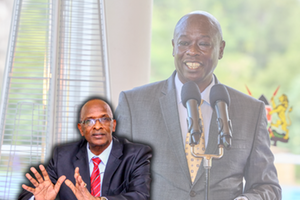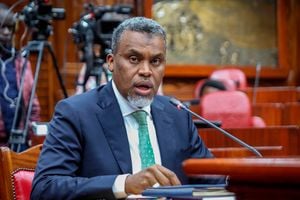UNHCR seeks $1.3bn to assist South Sudanese refugees

South Sudanese refugees sell food at the Ngomoromo border post, Uganda.
What you need to know:
- According to the UNHCR, about 80 per cent of the 2.2 million South Sudanese refugees are women and children.
- In a press release announcing the funds appeal, the money will also go towards helping the refugees’ host communities in the Democratic Republic of Congo, Ethiopia, Kenya, Sudan and Uganda.
The United Nations High Commissioner for Refugees (UNHCR) is seeking $1.3 billion (about Sh168 billion)funding to assist South Sudanese refugees displaced by conflict, the majority of whom are women and children.
According to the UNHCR, about 80 per cent of the 2.2 million South Sudanese refugees are women and children. In a press release announcing the funds appeal, it said the funding will also go towards helping the refugees’ host communities in the Democratic Republic of Congo (DRC), Ethiopia, Kenya, Sudan and Uganda.
The funding is majorly meant for programmes earmarked to prevent and respond to gender-based violence. It also aims to provide digital cash assistance, and other resilience-enhancing initiatives such as access to finance and training, and to help refugees and local communities generate income, supplement their needs and live in dignity.
“The neighbouring countries are bearing the strain of the crisis amid staggering levels of underfunding, prolonged drought, and severe food shortages, including food ration cuts for refugees.”
Grim situation
The appeal comes amid a worsening economic outlook across the region as the long-term impact of Covid-19 and the ripple effects of the war in Ukraine have pushed up fuel and food prices and increased unemployment.
It also comes in the backdrop of the worst drought in sub-Saharan Africa in 40 years that continues to have severe effects on women, girls and children more than men.
Under the South Sudan Refugee Response Plan, the UNHCR is urging the international community to scale up support for the millions of refugees who are unable to return home as their country continues to face a fragile peace and security environment, marked by cycles of sporadic violence and the impacts of an unfolding climate crisis.
According to Relief Web, the ongoing conflict and growing insecurity in South Sudan has exposed women and girls to ever greater risks of sexual and gender-based violence (SGBV). The humanitarian information service adds that about 2.6 million people in South Sudan were at risk of SGBV in 2022, a staggering 25 per cent increase from 2021 estimates.
Nearly 40 per cent of women and girls reported having to avoid essential public places like water points, washrooms and markets, as well as firewood collection sites, out of fear of being attacked, raped or sexually exploited.
Safe spaces
Across South Sudan, UNFPA has been supporting safe spaces for women and girls affected by humanitarian crises, providing sexual and reproductive health services, protection and information in a secure setting that reached more than 3,300 survivors in 2021.
Last year, the UN Commission on Human Rights lifted the lid off what it termed “hellish existence for women and girls”, with widespread rape being perpetrated by armed groups across Africa’s youngest country. The commission, in a report detailing the situation of human rights in South Sudan, noted sexual violence has been instrumentalised as a reward and entitlement for youth and men participating in conflict.
It added that rape is often used as part of military tactics for which government and military leaders are responsible, either due to their failure to prevent these acts, or for their failure to punish those involved.
Yasmin Sooka, the chair of the UN Commission on Human Rights in South Sudan, described it as outrageous and completely unacceptable that women’s bodies are systematically used on this scale as the spoils of war.
Sexual violence survivors detailed brutal and prolonged gang rapes perpetrated against them by multiple men, mostly as their husbands, parents or children were forced to watch, though helpless to intervene.
Women across all ages recounted being raped multiple times while other women were also being raped around them.





